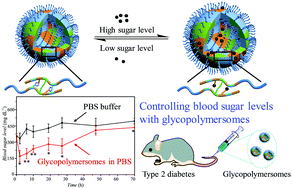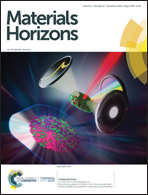Controlling blood sugar levels with a glycopolymersome†
Abstract
Diabetes mellitus is a group of metabolic disorders with lifelong high blood sugar levels. Patients with diabetes must give themselves shots of insulin and/or other medication every day, usually accompanying poor blood sugar control and patient compliance. To meet this important challenge, we propose a noninsulin and drug-free strategy for long-acting regulation of blood sugar levels using a glycopolymersome that can reversibly sop up and squeeze out glucose in the blood stream. This glycopolymersome is self-assembled using a sugar and phenylboronic acid derivative-containing copolymer, poly(ethylene oxide)-block-poly[(7-(2-methacryloyloxyethoxy)-4-methylcoumarin)-stat-3-acrylamidophenylboronic acid-stat-N-acryloyl glucosamine] [PEO-b-P(CMA-stat-AAPBA-stat-AGA)]. As its AAPBA moiety dynamically binds to its glucosyl moiety and glucose in the blood stream, this glycopolymersome can function as a glucose storage device by reversibly substituting sugar: AAPBA actively tucks away extra glucose, releasing it gradually as the body needs it. Accordingly, it swells or shrinks in size at high/low glucose levels. In vitro, the critical glucose concentration for the handover between the uptake and the release is around 100 mg dL−1, which matches with normal human blood sugar levels (70–110 mg dL−1). In vivo, this displays excellent long-acting antidiabetic effects towards type 2 diabetic mice within 30 h upon one shot, showing no side effects. Overall, this ‘controlling sugar with sugar’ concept holds promise for designing a range of new nanosized devices to regulate blood sugar levels without medication.



 Please wait while we load your content...
Please wait while we load your content...